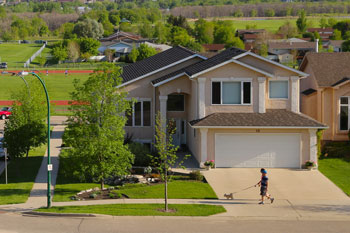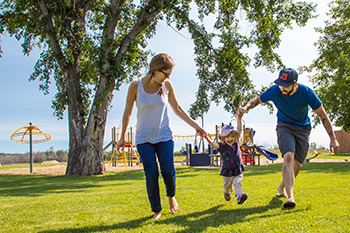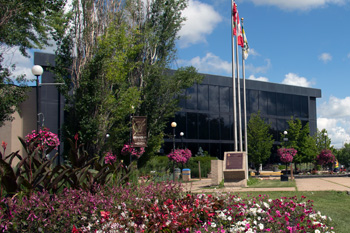Brandon Fire & Emergency Services has done its job to put the fire out and performed some basic clean-up work. It is now your responsibility to repair the fire damage and replace damaged or destroyed items. We hope that these tips will be useful.
First, we would like to answer some questions you might have about our fire operations and procedures.
- Was it really necessary to break the windows and put holes in the roof?
As a fire burns, it moves upward, then outward. Removing windows and cutting holes in the roof (ventilation in firefighting lingo) stops that damaging outward movement of superheated smoke and enables us to locate potential victims, and fight the fire more efficiently. This also results in less overall damage and reduces the risk of explosion and serious injury to firefighters. - Why did the firefighters put holes in the walls and ceiling?
They had to be absolutely sure there was no "hidden" fire inside the walls, ceilings, and partitions.
If you have any questions about our operations or the fire itself, please feel free to call the Fire Prevention Division of the Brandon Fire & Emergency Services (729-2409) during regular business hours.
Insurance
The first thing to do after a fire is to protect yourself from additional losses. Under some insurance policies (mostly commercial), there is an obligation by the insured to prevent further damage to the property in whatever way is reasonably possible. For example, by making sure that the fire area is inspected thoroughly to prevent the rekindling of the fire. Before attempting any cleaning or repairs notify your insurance agent for confirmation on how and when to proceed.
The Brandon Fire & Emergency Services will do its utmost to secure your property after a fire. We will remove as much water and debris as possible and protect lightly damaged and undamaged property. We will also use plastic to cover broken windows and ventilation openings in the roof.
If you are forced to stay elsewhere, remove all your valuables. If the Brandon Fire Department is investigating the fire, a police officer, with the permission of the Brandon Fire & Emergency Services investigator, will accompany you through the home/office while you remove your valuables. They will make an inventory of the property taken with you. If you are out of town at the time of the fire, the Fire Department will ensure that your home or office is protected from further damage.
If you rent your property, contact the owner of the building, who should then notify his/her insurance agent. Whether the property is insured or not, you should contact your local municipal Office regarding possible tax reductions.
The simplest way of replacing insurance policies that may be lost in a fire is to contact your insurance agent.
Electrical Appliances
Do not use wet or damaged appliances until they have been properly serviced. If the Fire Department or other agency has turned off the power during the fire, call the Public Utilities Commission or Manitoba Hydro to have these services restored. Do not try to do it yourself.
Gas Appliances
If your gas supply has been turned off, do not try to restore the service yourself. Call the Centra Gas and have them do it for you. They will test your supply line and also check your appliances when they restore service.
Food
Wash canned goods in detergent and water. Do the same for food in jars. If labels come off, be sure to mark the contents of the can or jar with a grease pencil. Do not use canned goods if the cans have bulges, dents or rust.
- If your freezer has stopped running, you can still save the frozen food.
- Keep the freezer closed. Your freezer has enough insulation to keep food frozen for at least one day, perhaps as many as two or three days.
- Move your food to another freezer. Before transporting it, wrap the frozen food in newspapers and blankets, or use insulated boxes.
- If your food has thawed, observe the following precautions:
- Fruit can be refrozen if it still tastes and smells good. Otherwise, it should be eaten at once.
- Vegetables can be refrozen if they still contain ice crystals.
Do not refreeze vegetables if they have thawed completely. If the vegetables have thawed and cannot be used soon, throw them out. If you have any doubts whatsoever concerning the quality of any food, don't take a chance. Throw it out.
To remove odour from our refrigerator or freezer, wash the inside with a solution of baking soda and water, or use 250 ml (1 cup) of vinegar or household ammonia to 4.5 litres (1 gallon) of water. Some baking soda in an open container, or a piece of charcoal, can be placed in the refrigerator or freezer to further absorb any bad odour. If the refrigerator is not running. Leave the door open to air it out completely.
Food Establishments
Restaurants and other food establishments must cease all operations after a fire until the premises have been inspected by the Regional Health Unit.
Documents and Records
To simplify recordkeeping, use separate credit cards for additional living expenses and for contents purchases.
Here is a checklist of documents which may have to be replaced due to damage or loss during a fire:
- Birth Certificates
- Drivers' Licenses
- Bank Books
- Insurance Policies
- Military Discharge Papers
- Credit Cards
- Title to Deeds
- Manitoba Health Insurance Cards
- Stocks and Bonds
- Social Insurance Cards
Welfare clients should notify their caseworker if any problems arise after a fire.
If your birth, death or marriage records have been destroyed, contact the appropriate Provincial ministry. For replacement of Social Insurance Cards, contact the nearest Canada Employment Centre. Citizenship papers may be replaced by contacting the Federal Government Citizenship Office.
Passports may be replaced by contacting the Passport Office of the Department of External Affairs. For replacement of records of entry to Canada or landed immigrant papers, contact the Canadian Immigration Centre.
For destroyed Drivers' Licenses or Vehicle Registration Papers, contact your local Manitoba License Bureau.
It is strongly recommended to utilize a bank safety deposit box for storage of important and valuable documents.
Money Replacement
If you have money that has been only partially burned, you can take the remainder to your local bank manager for possible replacement. If your Canada Savings Bonds have been mutilated or destroyed, contact the manager of the bank or trust company where the bonds were purchased, approximate date or time period when the bonds were purchased, denominations and an approximate number of each.
Cleaning and Restoring Procedures
Flooring and Rugs
If water seeps underneath linoleum, it can cause odours and warp the wood floor. Contact a linoleum dealer to find out what solvent should be used to loosen the linoleum cement without damaging the linoleum. After removing the linoleum, make sure the floor underneath is completely dry before replacing it.
If water seeps underneath linoleum, it can cause odours and warp the wood floor. Contact a linoleum dealer to find out what solvent should be used to loosen the linoleum cement without damaging the linoleum. After removing the linoleum, make sure the floor underneath is completely dry before replacing it.
Rugs and carpets should also be thoroughly dried. Throw rugs can be cleaned by beating, sweeping or vacuuming, and then shampooing. Rugs should be dried as quickly as possible. Lay them flat, and expose them to a circulation of warm, dry air. A fan turned on the rugs will speed up the process of drying. Make sure the rugs are completely dry. Even though the surface seems to be dry, any moisture remaining at the base of the tufts can quickly rot a rug. For information on cleaning and preserving carpets, contact a carpet dealer.
Clothing
Be selective about the clothes you clean, some may be too old to warrant the extra cleaning expense.
Smoke odour and soot can often be washed from your clothing. The following formula is useful for clothing that can be bleached:
- 60-75 ml - trisodium phosphate - 6 tbsp
- 250 ml - Lysol or any household chlorine bleach - 1 cup
- 4.5 litres water - 1 gallon
- To remove mildew, wash the fresh stain with soap and water. then rinse the garment and dry it in the sun. If the stain is still there, use lemon juice and salt; 15 ml (1 tbsp.) perborate bleach to 420 ml (1 pt.) lukewarm water; or a diluted solution of household chlorine bleach. Test coloured garments before using the treatment. Cooking Utensils
- Before taking wool, silk or rayon garments to the dry cleaners, remove trimming, shoulder pads, etc. If the garment is damp or wet, dry it in a well-ventilated area. Shake the garment out and brush it well. Get it dry cleaned as soon as possible.
- Mix well, add clothes. Rinse with clear water. Dry well. Substituting 30 ml (2 tbsp.) sodium hypochlorite for the trisodium phosphate is also effective.
Pots, pans, flatware, etc., should be washed with soapy water, rinsed well, and then polished with a finely powdered cleanser. Copper and brass can be cleaned with special polish, salt sprinkled on a piece of lemon or salt sprinkled on a cloth saturated with vinegar.
Leather and Books
Wipe leather goods with a damp cloth, then with a dry cloth. Stuff purses and shoes with newspapers to retain shape. Leave suitcases open. Leather goods should be dried away from direct heat and sun. When leather goods are dry, clean them with saddle soap. Steel wool or a suede brush can be used. Rinse leather or suede jackets in cold water and dry them away from heat and sun.
Books can be dried by placing them on end, with the pages separated. Then they should be piled and pressed to prevent the pages from crinkling. Alternating drying and pressing will help prevent mildew until the books are thoroughly dry. A fan turned on the books will help them dry. For very damp books, sprinkle cornstarch or talc between the pages, leave for several hours, and them brush.
Soot and Smoke Odour
To assist in removing the odour of soot and smoke from walls, furniture and floors, mix one of the following solutions and place containers of it throughout the building as a deodorizer. Do not apply the solution directly to the contents or the building.
Solution A:
- 60-75 ml - trisodium phosphate 4-6 tbsp.
- 250 ml - Lysol or any chlorine bleach - 1 cup
- 4.5 litres water - 1 gallon
Solution B:
- 30 ml - sodium hypochlorite - 2 tbsp.
- 4.5 litres water - 1 gallon
- Use with Lysol or any chlorine bleach
Walls and Ceilings
Trisodium phosphate and sodium hypochlorite can be obtained at a local hardware store. Protect your hands by wearing rubber gloves when mixing or using these types of solutions.
Problems could be experienced when cleaning walls, especially glazed walls and high walls. Walls may be washed down while wet. Use a mild soap or detergent. Wash a small area at a time working from the floor up except for high walls which should be washed from the top down. Then immediately rinse the wall with clear water.
Ceilings should be washed last. Before paintings severely smoke-stained ceilings and walls, a special sealer (S.P.S) should be used to eliminate the dark colour bleeding through the finished painted surface after completion. Do not repaint any walls or ceilings until they are completely dry.
Wood Furniture
It is strongly recommended that soot and smoke be cleaned from the top of flat surfaces of fine wood furniture as soon as possible after a fire because different types of smoke (from plastics, rubber, electrical wiring, etc.) affect the various surface finishes in different ways. Speedy cleaning may eliminate expensive refinishing costs and in some instances severe surface damage. Furniture may be treated in the following manner:
- Clear off mud and dirt.
- Remove drawers. Let them dry thoroughly so there will be no sticking when they are replaced.
- Scrub with stiff brush and cleaning solution.
- Wet wood can decay and mold, so dry it thoroughly. Open doors and windows for good ventilation. Turn on your furnace or air conditioner, if necessary.
- If mold forms, wipe the wood with a cloth soaked in a mixture of water and kerosene, or borax dissolved in hot water.
- Do not dry furniture in the sun. The wood will warp and twist out of shape.
- To remove white spots or film, rub the wood surface with a cloth soaked in a solution of 125 ml (1/2 cup) each of household ammonia and water, always rubbing the grain. Then wipe dry and polish with wax, or rub surface with the grain using a cloth soaked in a solution of 125 ml (1/2 cup) each of turpentine and linseed oil. Be careful. These materials are flammable. You can also rub the wood surface with the grain using a 4/0 steel wool pad dipped in liquid polishing wax. Wipe the surface with a soft cloth and then buff.
Fixtures and Countertops
Bathroom and kitchen fixtures, glazed wall tiles and arborite countertops should also be cleaned as quickly as possible in much the same manner as wood.
Smoke Odour Counteracting Services
Refer to the yellow pages of your telephone directory for a reputable firm to perform these services.
Locks and Hinges
Locks, especially iron locks, should be taken apart, wiped with kerosene and oiled. If locks cannot be removed, squirt machine oil through a bolt opening or keyhole, and work the knob to distribute the oil. Hinges should also be thoroughly cleaned and oiled.







